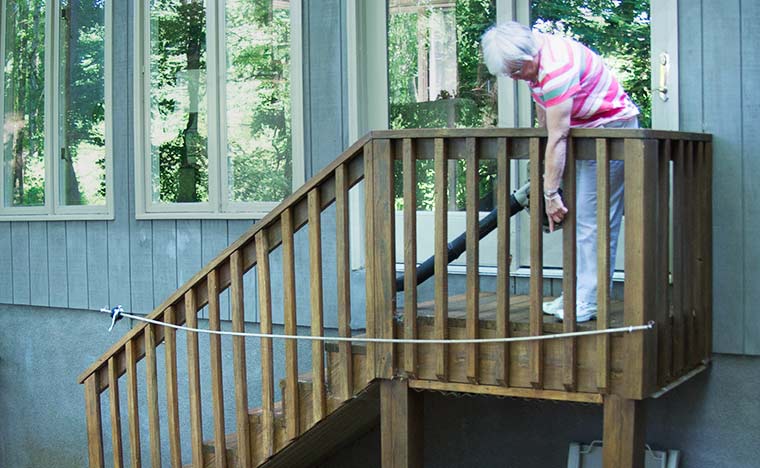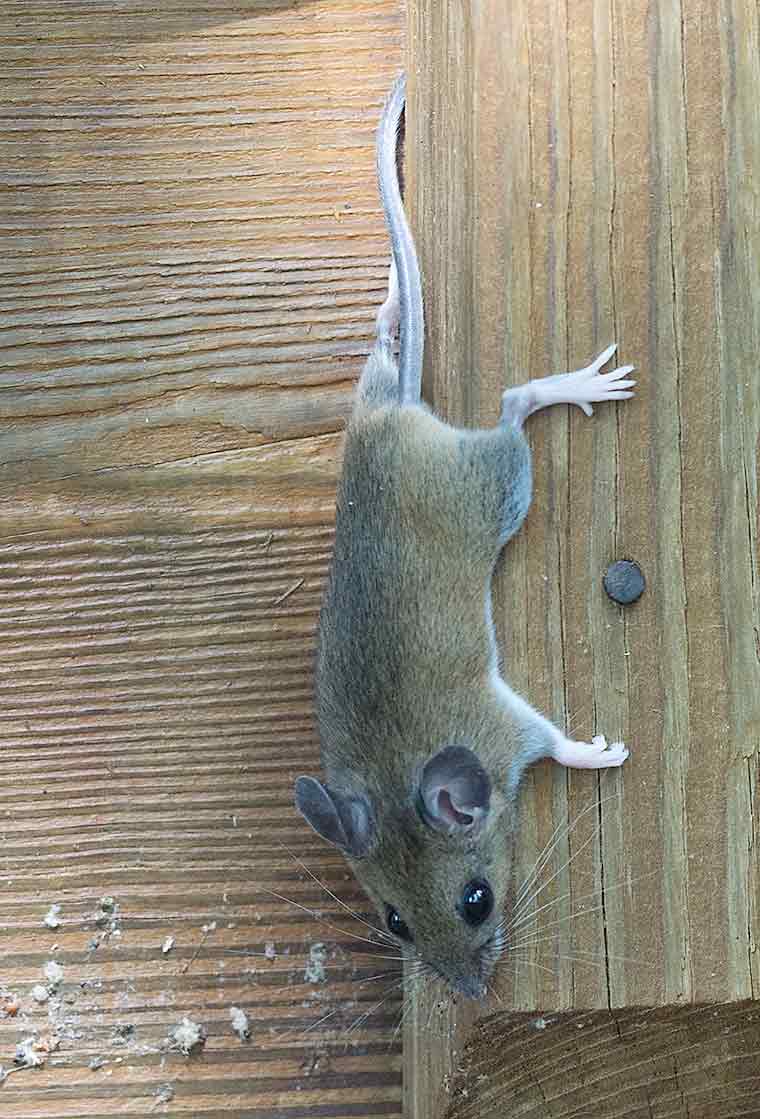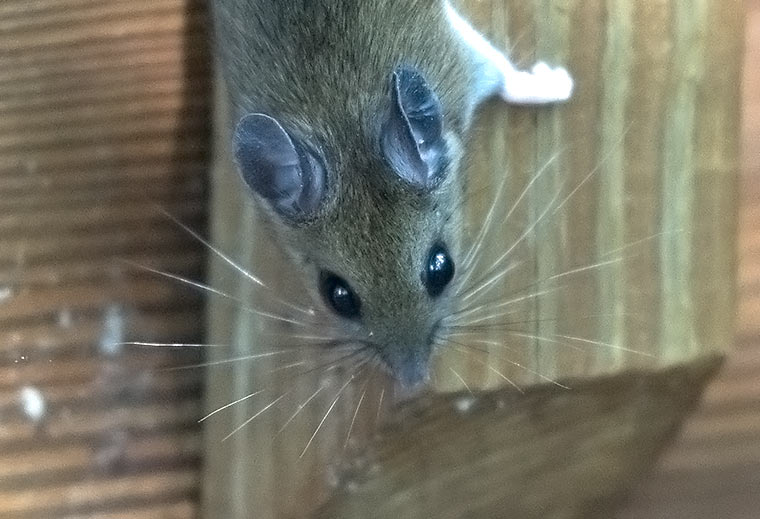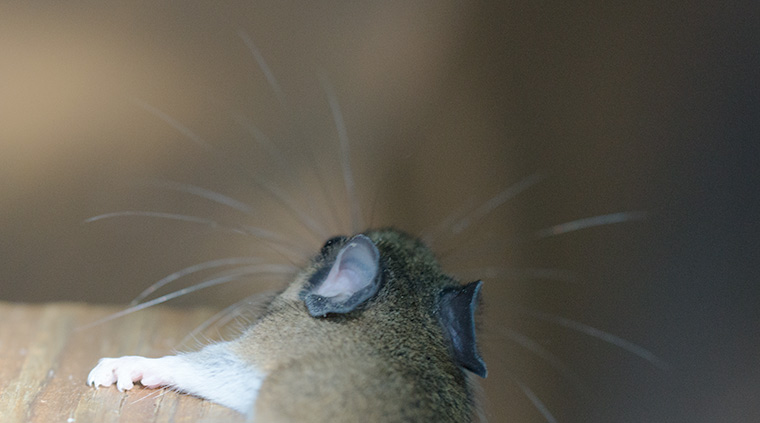I was working at my computer while Joyce was outside blowing the debris off the driveway and the back deck. I could hear the leaf blower running outside, but then I heard a loud rapping on the door that leads from the living room out onto the deck stairs. When I turned around, Joyce was trying to signal something to me with her free hand. I realized she was mimicking taking a photograph. So I grabbed a camera and hurried out onto the deck through a door leading from the garage.
 When I arrived she was alternately shouting something and pointing down from where she was standing. I could hardly hear her above the roar of the leaf blower, and I could not see anything to photograph in the direction she was pointing. I got a bit closer before I realized she was yelling “mouse”. I could not see any mouse, but I took several pictures blindly in the direction she was pointing. After a minute or so of her shouting and pointing, and me trying to find a mouse, I finally spotted it clinging to one of the deck posts. I took several photographs, and I was even able to hand the camera up to Joyce. She took some photographs before the mouse decided enough was enough and ran off into the woods.
When I arrived she was alternately shouting something and pointing down from where she was standing. I could hardly hear her above the roar of the leaf blower, and I could not see anything to photograph in the direction she was pointing. I got a bit closer before I realized she was yelling “mouse”. I could not see any mouse, but I took several pictures blindly in the direction she was pointing. After a minute or so of her shouting and pointing, and me trying to find a mouse, I finally spotted it clinging to one of the deck posts. I took several photographs, and I was even able to hand the camera up to Joyce. She took some photographs before the mouse decided enough was enough and ran off into the woods.
 I am not sure why the mouse decided to stop part way down the deck post in plain sight. I do know that predators are very attuned to movement, and they are less able to pick out motionless prey from the background. So the best defense may be to stay very still until the danger has passed. Joyce said she was going up the steps to blow off the landing when she saw it scurry over the edge. After she spotted it below her, she was afraid to turn off the leaf blower, because that might somehow cause the mouse to continue its escape.
I am not sure why the mouse decided to stop part way down the deck post in plain sight. I do know that predators are very attuned to movement, and they are less able to pick out motionless prey from the background. So the best defense may be to stay very still until the danger has passed. Joyce said she was going up the steps to blow off the landing when she saw it scurry over the edge. After she spotted it below her, she was afraid to turn off the leaf blower, because that might somehow cause the mouse to continue its escape.
This is a wild mouse, not a house mouse (Mus musculus). It is a member of a group called Deer Mice (genus Peromyscus). There are two species in our area that are very similar, the White-footed Mouse (P. leucopus) and the Cotton Mouse (P. gossypinus). They are difficult to tell apart, so take your pick! It certainly is a handsome creature.
 A closer view shows that our mouse is well-adapted for nocturnal activity. It has large ears and eyes plus an impressive array of whiskers.
A closer view shows that our mouse is well-adapted for nocturnal activity. It has large ears and eyes plus an impressive array of whiskers.
 Joyce’s photograph from above shows our mouse’s large ears and demonstrates the lateral extent of the whiskers. Such a spread of sensitive hairs would certain help navigation in the dark.
Joyce’s photograph from above shows our mouse’s large ears and demonstrates the lateral extent of the whiskers. Such a spread of sensitive hairs would certain help navigation in the dark.
In the western United States, Deer Mice have been shown to be carriers of hantaviruses, which cause very serious, potentially fatal diseases. In the Eastern U. S., Deer Mice are the reservoirs for the spirochete (Borrelia burgdorferi), which causes Lyme disease in humans. Deer Ticks (Ixodes scapulars) prefer to feed on deer, but acquire the Lyme disease spirochaete when they occasionally feed on Deer Mice. The infected tick can then transmit Lyme disease to humans. Deer ticks never acquire the Lyme disease agent from deer, they must acquire the spirochaete from an infected mouse. Deer Mice carry the Lyme disease spirochaete, but show no symptoms of disease.
